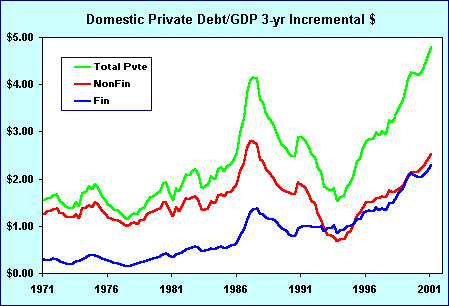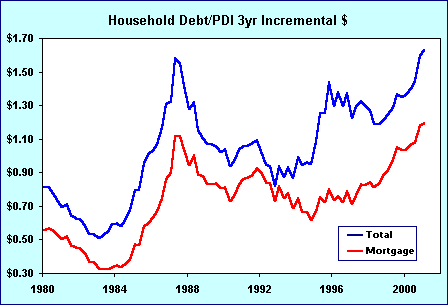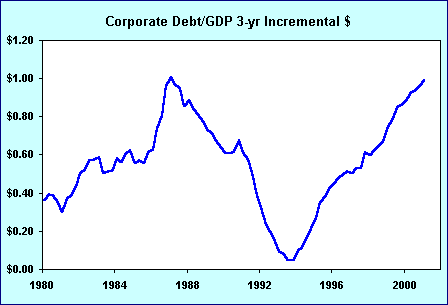<center><font size="+2" color="red">Lend Me a Little Prosperity</font></center>
In the six months from the peak of the Suckers' Rally in the New Era, the US managed to exceed even its own inordinate, and ultimately destructive, reliance upon debt to buy consumption. For every extra dollar of non-government GDP, there was $7.90 of extra private domestic debt incurred, split pretty evenly between the financial and non-financial sectors.
Not only is this a truly extraordinary pace of leverage - and one which shows the increasing futility of the inflation which the Fed and its foreign counterparts are encouraging - but the fact that every extra dollar of debt had to be washed through the financial system reflects upon the utter inability of the US savings pool to sustain activity in the manner in which it is currently taking place.
Whether we are buying consumption-dominated 'growth' by relaying other nations' monies (which may themselves be saved or created) through US banks and other financial institutions, or by creating them domestically out of thin air - this is the perpetual motion machine on which the whole world has come to rely.
<center>
 </center>
</center>
Given that we expect companies to earn something of the order of 6-7% of GDP in pre-tax profits over the long haul, running up nearly four times that amount in debt for each dollar of sales, even at the cheapest conceivable rate of 4.25% for 90-day A2/P2 CP, is equivalent to an interest bill some 2 ½ times the expected return. Fund it instead at the 9.5% available to B1 industrials and the multiples become truly chastening. This is clearly not something which is to be countenanced for any length of time.
In fact, taking a larger sample, the last three years have seen $4.80 in extra debt written for every $1 of extra private GDP - a post-war record. The financial component is unprecedented at $2.28, while the non-financial component was only exceed in the overlapping three-year periods which each ended in the last nine months before the Crash of '87.
<center>
 </center>
</center>
Households have run up $1.63 in extra debt ($1.19 of that in mortgages) for every extra dollar of disposable income in the last three years, taking their debt/income ratio to over 100%, a near15% increase since the Bubble began in 1995. Over the same period, Corporates are a penny short of hitting the buck-for-buck figure seen in 1987, and have seen debt/profits soar from 23.7 to 39.5 in the process, while debt/PGDP hit a record 56.3%.
Perhaps this last is not too surprising when we note that the Great Productivity Mirage of the last six years has witnessed cumulative 'investment' spending $990 billion in excess of internally-generated funds, while the Great CEO Options Scam saw $828 billion of the most expensive equity in corporate history bought back in the same period, to leave a $1.82 trillion hole in aggregate balance sheets - equivalent to fully one quarter of average private GDP over the period!
The thirst for funds this has generated and which the Fed seems determined to slake, even if the draught proves a toxic one, intensified in the last quarter with a record-ever net issuance of corporate debt, to the tune of an official $100 billion exactly.
<center>
 </center>
</center>
This has coincided with a record net foreign contribution of $68.2 billion to this total, and means that in the seven quarters since the Y2k scare combined with Greenspan's infamous late '99 Boca Raton promulgation of the productivity myth to spark the HyperBubble, corporate debt to the sum of $364 billion has been issued and fully $345 billion, or 94.5%, has been financed abroad.
Circumstantially, this was undertaken largely by Europeans rather than the Japanese, in Q1 at least, since MOF figures only show $6 billion or so of Japanese flows (some at the expense of other nations), while the EuroZone exported at least $45 billion to bonds in all foreign destinations in the same period.
It must also be noted that there was also a record foreign subsidy to US home-owners in the first three months of the year in the form of $38.9 billion in GSE debt purchased by the private sector. We have already pointed out the $35 billion extra which has appeared since September in the Agency debt category in the Fed custody accounts, where it is held for foreign monetary authorities. Indeed, in the last year alone $195 billion out of the $300 billion overall increase in GSE paper outstanding - two thirds, no less - has gone offshore.
So the mechanism is still very much in place: all major central banks are helping destroy their currencies through over issue of bank credit - these depredations largely showing up in their external valuations, though now increasingly internally as well - in order to encourage their own citizens' American friends and customers unwittingly to destroy capital on a Herculean scale.
All this excess debt will have to be expunged at some point and brought back into a due proportion with the wealth-generating potential of humanity. There still seem to be only the same two historic routes to achieve this; debt-deflation, or price inflation and neither is particularly conducive for the performance of risk assets in real terms.
Here we must once again toll the mournful tocsin of European aggregate data. Though both highly volatile and so more illustrative than anything, last month Dutch industrial production fell to a level 23% below December's blow-off spike, while Spain's numbers dropped 11% from November.
At the same time, Dutch CPI, annualized over the last six months, hit 6.7% - the worst in 20 years. Norway YTD is at a similar mark - the worst in 12 years - while Denmark's last four months registered almost exactly the same 6.7% annualized rate.
Make no mistake, the world is a very sick place at the moment and the leeches attempting to treat this ague have only one remedy, that of applying a noxious physick to the creditor classes and of enacting a wholesale frustration of contracts amid monetary confusion and depreciation.
At the risk of repeating ourselves, we cannot find anything in the numbers which tells us that we should do anything other than to buy government inflation-protected securities and claims on revenue streams generated from the staples of civilised life, such as food, water, medicine and fuel. A little gold incurs ever less opportunity cost as official rates decline and is probably the cheapest option there is on the breakdown of the existing monetary order under the strain, though it must be appreciated that our technical readings were still pointing to a risk of one last southward lurch to $235 to unwind last month's disappointments, at least until Tuesday's push away from the $268.50 area gave hope that this would not have to be endured.'
This may appear to represent an extreme bunker mentality, but if you consider the arguments above and listen closely, you may just make out the distant rumble of a thousand-bomber raid.
Sean Corrigan
Capital Insight
<a href="http//www.capitalinsight.co.uk" target="web">www.capitalinsight.co.uk</a>
14 June 2001
Fair use for educational/research purposes only!
In the six months from the peak of the Suckers' Rally in the New Era, the US managed to exceed even its own inordinate, and ultimately destructive, reliance upon debt to buy consumption. For every extra dollar of non-government GDP, there was $7.90 of extra private domestic debt incurred, split pretty evenly between the financial and non-financial sectors.
Not only is this a truly extraordinary pace of leverage - and one which shows the increasing futility of the inflation which the Fed and its foreign counterparts are encouraging - but the fact that every extra dollar of debt had to be washed through the financial system reflects upon the utter inability of the US savings pool to sustain activity in the manner in which it is currently taking place.
Whether we are buying consumption-dominated 'growth' by relaying other nations' monies (which may themselves be saved or created) through US banks and other financial institutions, or by creating them domestically out of thin air - this is the perpetual motion machine on which the whole world has come to rely.
<center>

Given that we expect companies to earn something of the order of 6-7% of GDP in pre-tax profits over the long haul, running up nearly four times that amount in debt for each dollar of sales, even at the cheapest conceivable rate of 4.25% for 90-day A2/P2 CP, is equivalent to an interest bill some 2 ½ times the expected return. Fund it instead at the 9.5% available to B1 industrials and the multiples become truly chastening. This is clearly not something which is to be countenanced for any length of time.
In fact, taking a larger sample, the last three years have seen $4.80 in extra debt written for every $1 of extra private GDP - a post-war record. The financial component is unprecedented at $2.28, while the non-financial component was only exceed in the overlapping three-year periods which each ended in the last nine months before the Crash of '87.
<center>

Households have run up $1.63 in extra debt ($1.19 of that in mortgages) for every extra dollar of disposable income in the last three years, taking their debt/income ratio to over 100%, a near15% increase since the Bubble began in 1995. Over the same period, Corporates are a penny short of hitting the buck-for-buck figure seen in 1987, and have seen debt/profits soar from 23.7 to 39.5 in the process, while debt/PGDP hit a record 56.3%.
Perhaps this last is not too surprising when we note that the Great Productivity Mirage of the last six years has witnessed cumulative 'investment' spending $990 billion in excess of internally-generated funds, while the Great CEO Options Scam saw $828 billion of the most expensive equity in corporate history bought back in the same period, to leave a $1.82 trillion hole in aggregate balance sheets - equivalent to fully one quarter of average private GDP over the period!
The thirst for funds this has generated and which the Fed seems determined to slake, even if the draught proves a toxic one, intensified in the last quarter with a record-ever net issuance of corporate debt, to the tune of an official $100 billion exactly.
<center>

This has coincided with a record net foreign contribution of $68.2 billion to this total, and means that in the seven quarters since the Y2k scare combined with Greenspan's infamous late '99 Boca Raton promulgation of the productivity myth to spark the HyperBubble, corporate debt to the sum of $364 billion has been issued and fully $345 billion, or 94.5%, has been financed abroad.
Circumstantially, this was undertaken largely by Europeans rather than the Japanese, in Q1 at least, since MOF figures only show $6 billion or so of Japanese flows (some at the expense of other nations), while the EuroZone exported at least $45 billion to bonds in all foreign destinations in the same period.
It must also be noted that there was also a record foreign subsidy to US home-owners in the first three months of the year in the form of $38.9 billion in GSE debt purchased by the private sector. We have already pointed out the $35 billion extra which has appeared since September in the Agency debt category in the Fed custody accounts, where it is held for foreign monetary authorities. Indeed, in the last year alone $195 billion out of the $300 billion overall increase in GSE paper outstanding - two thirds, no less - has gone offshore.
So the mechanism is still very much in place: all major central banks are helping destroy their currencies through over issue of bank credit - these depredations largely showing up in their external valuations, though now increasingly internally as well - in order to encourage their own citizens' American friends and customers unwittingly to destroy capital on a Herculean scale.
All this excess debt will have to be expunged at some point and brought back into a due proportion with the wealth-generating potential of humanity. There still seem to be only the same two historic routes to achieve this; debt-deflation, or price inflation and neither is particularly conducive for the performance of risk assets in real terms.
Here we must once again toll the mournful tocsin of European aggregate data. Though both highly volatile and so more illustrative than anything, last month Dutch industrial production fell to a level 23% below December's blow-off spike, while Spain's numbers dropped 11% from November.
At the same time, Dutch CPI, annualized over the last six months, hit 6.7% - the worst in 20 years. Norway YTD is at a similar mark - the worst in 12 years - while Denmark's last four months registered almost exactly the same 6.7% annualized rate.
Make no mistake, the world is a very sick place at the moment and the leeches attempting to treat this ague have only one remedy, that of applying a noxious physick to the creditor classes and of enacting a wholesale frustration of contracts amid monetary confusion and depreciation.
At the risk of repeating ourselves, we cannot find anything in the numbers which tells us that we should do anything other than to buy government inflation-protected securities and claims on revenue streams generated from the staples of civilised life, such as food, water, medicine and fuel. A little gold incurs ever less opportunity cost as official rates decline and is probably the cheapest option there is on the breakdown of the existing monetary order under the strain, though it must be appreciated that our technical readings were still pointing to a risk of one last southward lurch to $235 to unwind last month's disappointments, at least until Tuesday's push away from the $268.50 area gave hope that this would not have to be endured.'
This may appear to represent an extreme bunker mentality, but if you consider the arguments above and listen closely, you may just make out the distant rumble of a thousand-bomber raid.
Sean Corrigan
Capital Insight
<a href="http//www.capitalinsight.co.uk" target="web">www.capitalinsight.co.uk</a>
14 June 2001
Fair use for educational/research purposes only!
